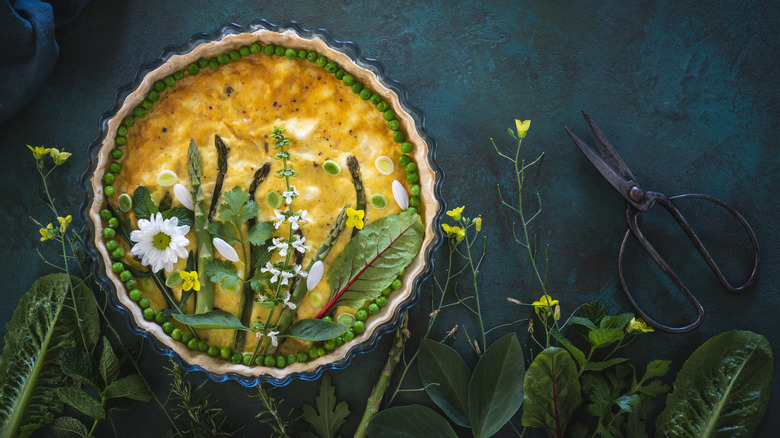Quiche Isn't Quite As French As We Thought
When you want to have breakfast, or breakfast for dinner, you can try the old standby foods like pancakes or an omelette, or you can enjoy a nice quiche to change things up a bit. Quiche is a savory dish that consists of a pastry crust filled with a mixture of eggs, cream, cheese, and various other ingredients, like bacon, ham, vegetables, or maybe seafood. The filling is then baked until it sets and the crust is golden brown.
Quiche can be served as a main course for breakfast, lunch, or dinner, or it can be a snack or dessert if you'd like. It's a versatile dish that can be made in many different variations such as savory, sweet, or made per your own preferences. It is then often paired with a salad, roasted vegetables, or fruit. One might think that quiche is complicated to make, but it's really not. It's also not as French as you may have assumed, because this great little dish actually has German roots.
From cake to quiche and beyond
Quiche originated in the Lorraine region of northeastern France during the Middle Ages, but before France conquered this region, it belonged to Germany and they already had a version of quiche: "kuchen" or "cake." There is still a similar dish served in Germany called "Zwiebelkuchen," which is often compared to quiche due to its similar crust and savory filling. Zwiebelkuchen is typically made with a pastry crust that's filled with a mixture of sautéed onions, bacon, eggs, and cream.
The original quiche, called "quiche Lorraine" after the area of France where it became popular, was made with a pastry crust filled with a mixture of eggs, cream, and smoked bacon. Over time, the recipe evolved and other ingredients such as cheese and vegetables were added to create new variations. Quiche became popular in other parts of Europe and the United States throughout the 20th century, and it became particularly trendy in the 1970s among the health-conscious, because it was often served in vegetarian and low-fat variations.
Quiche is healthy and ... feminist?
One interesting thing about quiche is how it became associated with the feminist movement. During the 1970s, when quiche was a highly popular food, women were seeking greater equality and independence, and quiche was seen as a sophisticated and "feminine" dish. The phrase "real men don't eat quiche" was popularized in a 1982 satirical book of the same name. This book made fun of certain foods being gendered and suggested that men who were secure in their masculinity could enjoy any type of food, including quiche. It was an example of how societal norms around anything from gender roles to gendered food can be limiting to men, women, and gender-nonconforming folks.
Whether it was meant to be a feminist food or not, quiche is still popular because of its versatility and convenience. You can use a pre-made crust if you don't have a lot of time to cook, it can be made ahead of time, and can be served cold or reheated. Quiche can also be nutritious, depending on the ingredients used. In one simple dish you get calcium, protein, vitamins, and minerals, as well as a nice dose of culinary history.


